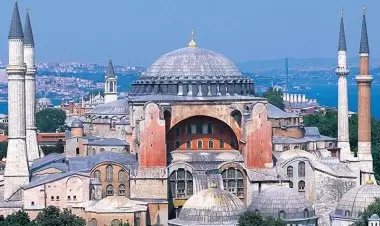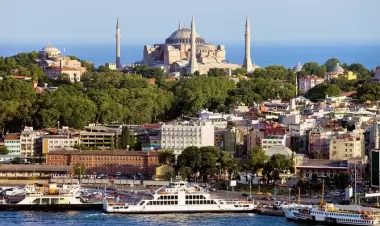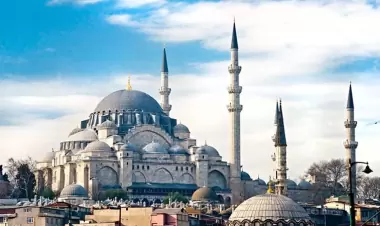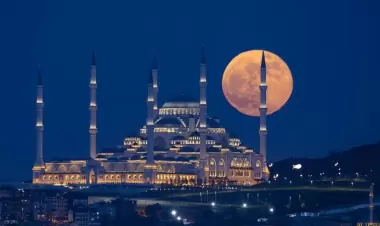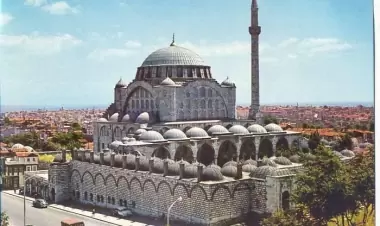Beyazıt Mosque

Discovering the Majestic Beyazıt Mosque
Beyazıt Mosque is more than just an architectural marvel;it is a living testament to Istanbul’s rich history and cultural heritage. From its grand dome and intricate designs to its ongoing spiritual and educational significance, the mosque remains an integral part of the city’s identity. Whether you’re a history lover, an art enthusiast, or simply a traveler seeking to explore Istanbul’s past, a visit to Beyazıt Mosque offers a unique opportunity to immerse yourself in the story of the Ottoman Empire and its lasting influence on modern Istanbul.
Nestled in the heart of Istanbul, the Beyazıt Mosque stands as a testament to the city's rich history and architectural prowess. Located in the lively Beyazıt Square, this grand mosque offers a glimpse into the opulence and splendor of the Ottoman Empire. Close to famed landmarks like the Grand Bazaar, Istanbul University, and the Beyazıt Library, it invites both travelers and history enthusiasts to explore a blend of history, culture, and art. Its majestic design, profound historical significance, and continued role in the life of the city make it a must-visit destination for those seeking to discover the depths of Istanbul’s cultural heritage.
A Brief History of Beyazıt Mosque

The Beyazıt Mosque was commissioned by Sultan Bayezid II in the late 15th century, around 1500. It was part of his larger vision to create a monumental complex that served both spiritual and social needs. Situated in a prime location in the city, the mosque symbolized the imperial power and grandeur of the Ottoman Empire. Its construction was part of Sultan Bayezid’s efforts to enhance Istanbul as the capital of the empire and to leave a lasting legacy of faith and culture.
Historically, Beyazıt Mosque has been integral to the daily life of Istanbul. Over the centuries, it has withstood numerous challenges, including earthquakes and fires, prompting restorations and reconstructions that have preserved its architectural glory. These transformations have allowed the mosque to remain a vibrant center of spiritual and community life in Istanbul.
Architectural Design:Ottoman Excellence

The Beyazıt Mosque is an embodiment of Ottoman architectural brilliance, designed by the renowned architect Hayreddin. The mosque’s design incorporates elements of both Seljuk and Ottoman styles, merging traditional and innovative techniques to create a harmonious and awe-inspiring space.
One of the most striking features of the mosque is its large central dome, which towers over the surrounding structures. The two elegant minarets flank the mosque, adding a sense of vertical grandeur to its presence. Inside, visitors are greeted by a spacious prayer hall adorned with intricate marble work, decorative tiles, and magnificent calligraphy. The rich colors and patterns of the tiles evoke the artistry of the Ottoman era, while the carefully crafted arches and columns create an atmosphere of serenity and majesty.
The layout of the mosque is also functional, with a spacious courtyard and surrounding areas designed to accommodate the needs of worshippers and visitors alike. The mosque’s architectural elements blend aesthetics with utility, reflecting the priorities of the time:both to inspire devotion and serve the community.
Cultural and Religious Significance

Beyazıt Mosque has played a pivotal role in the religious and cultural life of Istanbul since its establishment. As a place of worship, it remains an active mosque, offering regular prayers and religious services. It has also been a center for Islamic education, with its madrasa (Islamic school) supporting generations of scholars and intellectuals.
In addition to its religious functions, the mosque’s historical importance extends to its role in the broader social fabric of Istanbul. The complex has been a place where both scholars and ordinary citizens could gather, reflecting the inclusive and communal nature of the Ottoman Empire. Today, it continues to serve as a center of spiritual teaching, connecting Istanbul’s modern residents with their rich religious heritage.
The Surroundings:Beyazıt Square and Beyond
The Beyazıt Mosque is situated in the bustling Beyazıt Square, which has long been a central point in the historic peninsula of Istanbul. The square itself is an important gathering place, with the mosque acting as a key focal point. Visitors will find themselves immersed in a vibrant atmosphere, surrounded by significant landmarks such as the Grand Bazaar, one of the oldest and largest covered markets in the world, and the nearby Istanbul University, an institution of great historical and academic importance.
The Beyazıt Library, another nearby treasure, offers visitors the opportunity to explore Ottoman-era manuscripts and documents. The mosque, with its location near these historical landmarks, creates a harmonious blend of Istanbul’s past and present, making Beyazıt Square an essential cultural hub for locals and tourists alike.
Visiting Beyazıt Mosque Today
For those planning to visit, the Beyazıt Mosque is open to the public daily, though visitors should check for prayer times as the mosque remains an active site for worship. It is important to dress modestly when visiting, with women required to cover their heads and men to avoid wearing shorts. Shoes should be removed before entering the prayer hall.
After visiting the mosque, take time to explore Beyazıt Square and its surrounding area. The Grand Bazaar, just a short walk away, is a must-see for those looking to experience Istanbul’s lively shopping culture. Many local cafes and shops in the area offer refreshments and souvenirs, making it a great place to relax after a cultural excursion.
The mosque also hosts religious festivals and events, including lectures and community gatherings. These activities provide visitors with a deeper insight into the mosque’s contemporary role in Istanbul’s religious and cultural life.
Fun Facts and Lesser-Known Details
While the Beyazıt Mosque is undoubtedly famous for its architectural beauty, it also has a rich array of lesser-known stories and hidden details. For instance, many visitors may not notice the intricate inscriptions and symbols that decorate the mosque’s interior, each representing different elements of Islamic culture and Ottoman artistry. The mosque’s unique acoustic properties, designed to carry the sound of the imam’s voice across the large prayer hall, are another remarkable feature of its design.
In addition, the mosque’s role in Ottoman art and literature is often overlooked. Its depiction in historical paintings and works of literature provides a fascinating glimpse into the cultural life of Istanbul during the height of the Ottoman Empire.
The Atmosphere:A Sacred and Majestic Space

Upon entering the Beyazıt Mosque, visitors are immediately enveloped by a sense of serenity and reverence. The large central prayer hall, dominated by a grand dome, evokes a sense of awe with its expansive space and intricate design. The soft light filtering through the stained glass windows creates a tranquil atmosphere, while the sound of prayer and the hum of worshippers add to the spiritual ambiance.
The acoustics of the mosque are remarkably engineered, allowing the imam’s voice to resonate clearly throughout the prayer hall. The surrounding courtyard, with its peaceful gardens and shaded walkways, provides a place for reflection and contemplation, making it not only a religious space but also a peaceful retreat amidst the bustle of Istanbul.
Historical Importance for the Ottoman Empire

The Beyazıt Mosque was commissioned by Sultan Bayezid II in the late 15th century, specifically around 1500, during the height of the Ottoman Empire’s power. As part of a larger complex, which included a madrasa (Islamic school), a hospital, and a library, the mosque symbolized both religious and intellectual authority. Its construction was a part of Sultan Bayezid’s vision to enhance Istanbul’s status as the capital of the empire and to provide a space for spiritual and intellectual growth.
The mosque’s role extended beyond just religious worship;it was also a center for education and community life. The complex attracted scholars, students, and the general public, making it an integral part of the social and cultural fabric of the city. In the centuries since, the mosque has remained an important site for worship, education, and communal gathering, solidifying its place as one of Istanbul’s key cultural landmarks.
Construction Details:Ottoman Architectural Excellence

The Beyazıt Mosque is an exemplary representation of Ottoman architectural design. The mosque was designed by Hayreddin, the renowned architect who also contributed to the design of other famous Ottoman structures.
- Dome and Minarets: The mosque is crowned with a large central dome, measuring approximately 17 meters in diameter, which is supported by four main pillars. The dome’s height from the floor to the apex is about 35 meters. The two towering minarets on either side of the mosque are each about 65 meters tall, contributing to the mosque’s striking vertical presence and enhancing its grandeur. The minarets are adorned with elegant calligraphy and intricate stonework.
- Prayer Hall: Inside the mosque, the main prayer hall is an open, airy space with a rectangular layout. The floor area of the prayer hall is approximately 500 square meters, and it can accommodate hundreds of worshippers. The interior is decorated with beautiful tiles, calligraphy, and marble columns. The prayer hall is dominated by the large dome, with smaller semi-domes surrounding the space.
- Building Materials: The mosque was primarily constructed using local limestone, marble, and granite, ensuring both durability and a visually stunning appearance. The interior features Ottoman Iznik tiles, with their characteristic blue and white motifs, decorating the walls and floors. The wooden ceiling of the prayer hall is adorned with intricate designs that reflect Ottoman artistic sensibilities.
- Courtyard and Surrounding Structures: The mosque is part of a larger religious and social complex. The courtyard, with a colonnade surrounding it, is a serene space where worshippers gather before entering the mosque. Nearby, the complex includes a madrasa, a library, and a fountain, each designed to serve both religious and community functions.
Nearby Landmarks and Locations of Beyazıt Mosque

The Beyazıt Mosque is located in one of Istanbul’s most vibrant and historically rich areas, Beyazıt Square. Several notable landmarks are in close proximity to the mosque, making it a key point on any tour of Istanbul’s historic peninsula.
- Grand Bazaar (Kapalı Çarşı): Just a few minutes’walk from the mosque, the Grand Bazaar is one of the largest and oldest covered markets in the world. With thousands of shops selling everything from spices and textiles to jewelry and souvenirs, it is a must-see for any visitor.
- Istanbul University: Located adjacent to the mosque, Istanbul University is one of the oldest universities in the world, with a history dating back to 1453. The university’s historic buildings and lush green campus add to the cultural vibrancy of the area.
- Beyazıt Library: A short walk from the mosque, the Beyazıt Library is a beautiful Ottoman-era building housing thousands of historical manuscripts. It’s an ideal stop for those interested in Ottoman history and culture.
- Süleymaniye Mosque: A 15-minute walk from Beyazıt Mosque, this majestic mosque by the famous architect Mimar Sinan is another example of Ottoman architectural brilliance.
Reasons to Visit Beyazıt Mosque
- Architectural Marvel: The Beyazıt Mosque’s design is a perfect blend of Ottoman style, with its magnificent dome, elegant minarets, and intricate interior. The mosque’s use of light and space creates a profound sense of serenity that makes it an unforgettable experience for visitors.
- Historical Significance: As one of the oldest mosques in Istanbul, Beyazıt Mosque offers insight into the grandeur of the Ottoman Empire. Its role in the intellectual and religious life of the empire makes it a key historical monument that connects the past to the present.
- Spiritual and Cultural Hub: The mosque continues to serve as an active place of worship and a center for Islamic education. Visitors can experience not only its architectural beauty but also its ongoing role in Istanbul’s spiritual life.
- Location and Accessibility: Its central location in Beyazıt Square places the mosque in close proximity to other key Istanbul landmarks, making it easy to incorporate into a day of sightseeing. The proximity to the Grand Bazaar, Istanbul University, and other historical sites makes it a convenient and enriching stop for tourists.
- Cultural Experience: The mosque’s role in Ottoman art, literature, and culture is reflected in its design, inscriptions, and the stories that can be found within its walls. It’s a great place for those interested in learning about the deep cultural heritage of the Ottoman Empire.
Address of Beyazıt Mosque:
Beyazıt Mosque
Beyazıt Meydanı, 34126 Fatih
Istanbul, Turkey
It is located in Beyazıt Square, right in the heart of Istanbul's historic district, and is easily accessible from several major landmarks like the Grand Bazaar and Istanbul University.
Visitor Rules and Guidelines for Beyazıt Mosque:

Opening Hours:
- Beyazıt Mosque is generally open to visitors every day from early morning until evening, with the mosque closing briefly during prayer times for the congregational prayers. However, it is best to visit outside of prayer times to explore the mosque peacefully.
- Prayer Times: Visitors are asked to respect the prayer schedule and avoid visiting during the five daily prayers (especially Friday prayers, which can be quite busy).
Dress Code:
- As a place of worship, visitors are expected to dress modestly.
- Women are required to cover their heads with a scarf when entering the mosque. It is recommended to bring your own scarf, but scarves may be provided at the entrance.
- Both men and women should wear modest clothing that covers the shoulders, arms, and legs.
- Avoid wearing shorts, sleeveless tops, or revealing clothing.
Shoes:
- Visitors are required to remove their shoes before entering the mosque. There are shoe racks at the entrance where you can leave your footwear.
Behavior:
- Visitors are asked to remain quiet and respectful during their visit, as the mosque is a place of worship.
- Photography is generally allowed, but it is important to be discreet and avoid disturbing the worshippers.
- Visitors should refrain from speaking loudly, using phones inside the prayer hall, or taking photos during prayer times.
Accessibility:
- The mosque is free of charge to visit and open to all visitors, regardless of religion.
- The mosque is wheelchair accessible, though the surrounding areas and the courtyard may be challenging for those with mobility issues due to uneven surfaces.
Respectful Etiquette:
- While the mosque is open to tourists, please be mindful that this is still an active place of worship. If you plan to visit during prayer times, observe quietly and respectfully from the outer areas or courtyard.
- If you are unsure about anything, feel free to ask the mosque staff for guidance.
Additional Tips for Beyazıt Mosque Visitors:
- Nearby Attractions: The Beyazıt Mosque is close to several important landmarks, including the Grand Bazaar, Istanbul University, and the Beyazıt Library. You can easily spend a couple of hours exploring the area.
- Guided Tours: If you're interested in learning more about the mosque's history and significance, you can join a guided tour to gain a deeper understanding of its architecture and role in Ottoman culture.
View On Map
Loc: 41.01029255, 28.9653895753899
Content Index
Others in Same Category
This site was created by a person who was born in Istanbul and is a lover of Istanbul, with the aim of introducing the beauties of the city to be discovered.
If you are planning to visit Istanbul or would like to get more information, you can contact with us via contact us button on below:
Contact Us
